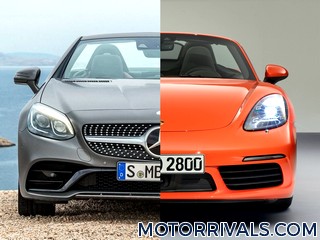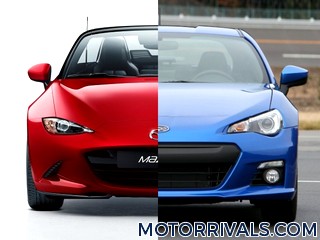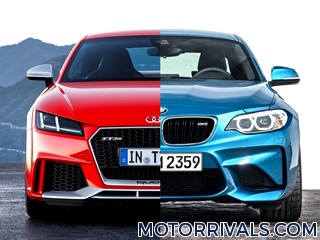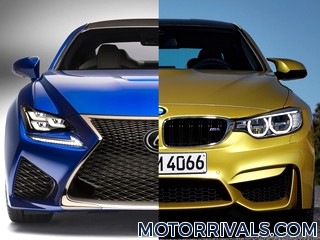2017 Audi S5 vs 2017 BMW M4
Audi Press Release Highlights
The new Audi S5 Coupé combines dramatic design with the performance of a sports car. Its newly developed, turbocharged V6 engine produces 260 kW (354 hp) and consumes just 7.3 liters of fuel per 100 km (32.2 US mpg). With an unladen weight of 1,615 kilograms (3,560.5 lb.), the car weighs 60 kilograms (132.3 lb.) less than the previous model. The precision-honed exterior design and the numerous S-specific details in the interior underscore the dynamic character of the Audi two-door sports coupé.
Audi equips the new S5 Coupé standard with LED headlights. The lower edge of the wide and flat Single frame extends much farther upward than in the previous model. The striking bumper is expressively shaped. At the front end, the new Audi S5 Coupé expresses its independence with additional sporty details, such as the S-specific radiator grille in matt twilight gray with double slats in matt aluminum silver. When viewed from the side, the new Audi S5 Coupé exhibits a characteristic, wave-shaped shoulder line. The rear end sports slim LED rear lights with dynamic turn signals. A distinctive spoiler in the body color on the luggage compartment lid improves the aerodynamics.
The drivetrain of the Audi S5 Coupé has also been completely updated. This also applies to the smooth, rapid and spontaneously shifting, eight-speed tiptronic. The layout of its gear sets and shifting elements results in low drag torques and thereby to a high efficiency level. The driver can select the D, S or E mode and can use shift paddles on the steering wheel for manual gear changes. As soon as the driver lifts off the accelerator at speeds between 55 and 160 km/h (34.2 and 99.4 mph), the transmission begins freewheeling mode if this will save fuel (exception: Mode S).
The Quattro permanent all-wheel drive system with its asymmetrically dynamic layout makes a major contribution toward sporty and stable handling of the new Audi S5 Coupé. During normal driving, its all-mechanical center differential directs 60 percent of the torque to the rear axle and 40 percent to the front. Wheel-selective torque control - an intelligent software function - complements the work of the Quattro drive system. In dynamic cornering, it applies minimal brake interventions at the wheels on the inside of the curve before they begin to spin. The optional sport differential provides for even more dynamic response when steering and accelerating. It distributes torque between the rear wheels via two superposition gears.
As an alternative to the standard S sport suspension with highly sensitive monotube shock absorbers, Audi also offers a version with S-specific damper control for the new S5 Coupé. The variable S sport suspension works with newly developed CDC dampers (CDC = continuous damping control) with electromagnetically actuated valves in their pistons.
The brakes are dimensioned to be large. At the front wheels, the internally-vented discs are 350 mm (13.8 in) in diameter. They are gripped by black (or optionally red) painted six-piston fixed calipers with rhombus S logos. Electronic Stabilization Control (ESC) operates even more precisely and sensitively than in the previous model. The driver can choose to deactivate it partially or entirely over two stages.
The new S5 Coupé comes standard with 18-inch wheels in a five-spoke start design. The 245/40-series tires weigh less than 12 kilograms (26.5 lb.). A number of 19-inch wheels are available as options.
The optional Audi phone box with wireless charging connects smartphones to the on-board antenna via near-field coupling and simultaneously charges them inductively according to the Qi standard. The Audi smartphone interface brings Apple Car Play and Android Auto into the car. For discerning hi-fi fans, the Bang & Olufsen Sound System with new 3D sound is available.
Audi equips the new S5 Coupé standard with LED headlights. The lower edge of the wide and flat Single frame extends much farther upward than in the previous model. The striking bumper is expressively shaped. At the front end, the new Audi S5 Coupé expresses its independence with additional sporty details, such as the S-specific radiator grille in matt twilight gray with double slats in matt aluminum silver. When viewed from the side, the new Audi S5 Coupé exhibits a characteristic, wave-shaped shoulder line. The rear end sports slim LED rear lights with dynamic turn signals. A distinctive spoiler in the body color on the luggage compartment lid improves the aerodynamics.
Powertrain
The completely redesigned, turbocharged 3.0 TFSI engine for the Audi S5 Coupé offers powerful performance. From its 2,995 cc of displacement, the V6 TFSI produces 260 kW (354 hp), which is 15 kW (21 hp) more than the previous engine. A constant 500 Nm (368.8 lb-ft) (plus 60 Nm/44.3 lb-ft) of torque is available from a low 1,370 all the way to 4,500 rpm. In the NEDC, the new 3.0 TFSI in the S5 Coupé consumes just 7.3 liters per 100 kilometers (32.2 US mpg). Fuel consumption has dropped by five percent compared with the predecessor engine. The turbocharger is located within the 90-degree V of the cylinder banks. It normally sits on the outside next to the crankcase. From 0 to 100 km/h (62.1 mph) takes 4.7 seconds.The drivetrain of the Audi S5 Coupé has also been completely updated. This also applies to the smooth, rapid and spontaneously shifting, eight-speed tiptronic. The layout of its gear sets and shifting elements results in low drag torques and thereby to a high efficiency level. The driver can select the D, S or E mode and can use shift paddles on the steering wheel for manual gear changes. As soon as the driver lifts off the accelerator at speeds between 55 and 160 km/h (34.2 and 99.4 mph), the transmission begins freewheeling mode if this will save fuel (exception: Mode S).
The Quattro permanent all-wheel drive system with its asymmetrically dynamic layout makes a major contribution toward sporty and stable handling of the new Audi S5 Coupé. During normal driving, its all-mechanical center differential directs 60 percent of the torque to the rear axle and 40 percent to the front. Wheel-selective torque control - an intelligent software function - complements the work of the Quattro drive system. In dynamic cornering, it applies minimal brake interventions at the wheels on the inside of the curve before they begin to spin. The optional sport differential provides for even more dynamic response when steering and accelerating. It distributes torque between the rear wheels via two superposition gears.
Chassis
The Audi S5 Coupé features a newly developed S sport suspension with five-link suspensions front and rear. With their low weight, the new parts also reduce fuel consumption. Audi also offers optional dynamic steering, which adapts its steering ratio to the vehicle's speed and the steering angle.As an alternative to the standard S sport suspension with highly sensitive monotube shock absorbers, Audi also offers a version with S-specific damper control for the new S5 Coupé. The variable S sport suspension works with newly developed CDC dampers (CDC = continuous damping control) with electromagnetically actuated valves in their pistons.
The brakes are dimensioned to be large. At the front wheels, the internally-vented discs are 350 mm (13.8 in) in diameter. They are gripped by black (or optionally red) painted six-piston fixed calipers with rhombus S logos. Electronic Stabilization Control (ESC) operates even more precisely and sensitively than in the previous model. The driver can choose to deactivate it partially or entirely over two stages.
The new S5 Coupé comes standard with 18-inch wheels in a five-spoke start design. The 245/40-series tires weigh less than 12 kilograms (26.5 lb.). A number of 19-inch wheels are available as options.
Technology
One highlight is the optional Audi virtual cockpit. It displays all key information in razor-sharp graphics on its 12.3-inch monitor. In the new MMI operating system, the flat menu structure is based on that of today's smartphones, including intelligent free-text search. MMI navigation plus with MMI touch and an 8.3-inch monitor top the infotainment range. MMI touch has a touchpad for zooming and scrolling and for entering characters. The system includes the Audi connect hardware component, which connects the new Audi S5 Coupé to the Internet via LTE. Passengers can freely surf and email with their mobile devices thanks to the integrated Wi-Fi hotspot with optional data packages. The driver can use the diverse online services from the Audi connect portfolio.The optional Audi phone box with wireless charging connects smartphones to the on-board antenna via near-field coupling and simultaneously charges them inductively according to the Qi standard. The Audi smartphone interface brings Apple Car Play and Android Auto into the car. For discerning hi-fi fans, the Bang & Olufsen Sound System with new 3D sound is available.
Safety
The new Audi S5 Coupé is at the front of its segment with a wide range of driver assistance systems. The systems come from the full-size class; their intelligent interplay represents another step on the road to piloted driving. Audi offers the same systems for the S5 Coupé as for the A5 Coupé.BMW Press Release Highlights
The launch of the new BMW M3 Sedan and new BMW M4 Coupe sees BMW M GmbH
revealing a new interpretation of the high-performance sports car – and
carrying the BMW M philosophy over into the fifth generation of the M3.
More than 40,000 examples of the fourth-generation BMW M3 Coupe were
built, and now the BMW M4 Coupe is poised to continue this success
story. The “M4” badge is a reference to the model series that provides
the basis for the new M model – and, for the first time, the Coupe will
be introduced at the same time as the four-door variant. Logic dictates
the latter will be christened the BMW M3 Sedan.
“Four generations of the BMW M3 have blended motor sport genes and uncompromised everyday usability within an emotionally rich overall concept,” explains Dr Friedrich Nitschke, President BMW M GmbH. “The BMW M3 Sedan and BMW M4 Coupe represent an ongoing commitment to this philosophy. The engine is the heart of every M model, and the new turbocharged six-cylinder unit fitted in the two new cars combines the virtues of a high-revving naturally aspirated unit with the strengths of turbocharger technology. A committed lightweight design concept produces a weight saving of around 80 kilograms over the outgoing M3. The BMW M3 and BMW M4 take motor sport technology from the track to the road, and thousands of laps of the legendary Nürburgring Nordschleife – the world’s most exacting race track – have readied the new models for that transition. Meticulous and passion-fuelled development work has underpinned the creation of two high-performance sports cars that set new standards in terms of overall concept, precision and agility.”
The high-revving six-cylinder in-line engine with M TwinPower Turbo technology newly developed for the new BMW M3 Sedan and new BMW M4 Coupe produces a maximum output of 431 hp. Its peak torque of 550 Newton metres (406 lb-ft) is available across a wide rev band and outstrips the figure recorded by the outgoing BMW M3 by roughly 40 per cent. And yet the engine also achieves a reduction in fuel consumption and emissions of around 25 per cent. Both the BMW M3 Sedan and BMW M4 Coupe cover the sprint from 0 to 100 km/h / 62 mph in 4.1 seconds (with the optional seven-speed M Double Clutch Transmission).
In the interests of maximising dynamic ability and ensuring excellent efficiency, weight savings of around 80 kilograms have been achieved over a comparably equipped predecessor model. The BMW M4 Coupe, for example, has a DIN kerb weight of 1,497 kilograms, thanks to the rigorous application of intelligent lightweight design measures. These include the increased use of lightweight materials such as carbon-fibre-reinforced plastic (CFRP) and aluminium for a number of chassis and body components. Indeed, both models feature a carbon roof.
One of the primary objectives in the development of the BMW M3 Sedan and BMW M4 Coupe was to ensure the new cars offered impressive race track capability. Hence the presence of a track-specification cooling system, which ensures that the optimum temperature balance for the engine, turbochargers and transmission is maintained at all times.
In order to accentuate the racing character of the two models in terms of both their technical composition and the fine-tuning of the cars, the engineers worked closely with BMW Motorsport’s professional racing drivers during the development phase. For example, DTM drivers Bruno Spengler and Timo Glock took part in the extensive testing and set-up work carried out at the Nürburgring-Nordschleife circuit.
“Four generations of the BMW M3 have blended motor sport genes and uncompromised everyday usability within an emotionally rich overall concept,” explains Dr Friedrich Nitschke, President BMW M GmbH. “The BMW M3 Sedan and BMW M4 Coupe represent an ongoing commitment to this philosophy. The engine is the heart of every M model, and the new turbocharged six-cylinder unit fitted in the two new cars combines the virtues of a high-revving naturally aspirated unit with the strengths of turbocharger technology. A committed lightweight design concept produces a weight saving of around 80 kilograms over the outgoing M3. The BMW M3 and BMW M4 take motor sport technology from the track to the road, and thousands of laps of the legendary Nürburgring Nordschleife – the world’s most exacting race track – have readied the new models for that transition. Meticulous and passion-fuelled development work has underpinned the creation of two high-performance sports cars that set new standards in terms of overall concept, precision and agility.”
The high-revving six-cylinder in-line engine with M TwinPower Turbo technology newly developed for the new BMW M3 Sedan and new BMW M4 Coupe produces a maximum output of 431 hp. Its peak torque of 550 Newton metres (406 lb-ft) is available across a wide rev band and outstrips the figure recorded by the outgoing BMW M3 by roughly 40 per cent. And yet the engine also achieves a reduction in fuel consumption and emissions of around 25 per cent. Both the BMW M3 Sedan and BMW M4 Coupe cover the sprint from 0 to 100 km/h / 62 mph in 4.1 seconds (with the optional seven-speed M Double Clutch Transmission).
In the interests of maximising dynamic ability and ensuring excellent efficiency, weight savings of around 80 kilograms have been achieved over a comparably equipped predecessor model. The BMW M4 Coupe, for example, has a DIN kerb weight of 1,497 kilograms, thanks to the rigorous application of intelligent lightweight design measures. These include the increased use of lightweight materials such as carbon-fibre-reinforced plastic (CFRP) and aluminium for a number of chassis and body components. Indeed, both models feature a carbon roof.
One of the primary objectives in the development of the BMW M3 Sedan and BMW M4 Coupe was to ensure the new cars offered impressive race track capability. Hence the presence of a track-specification cooling system, which ensures that the optimum temperature balance for the engine, turbochargers and transmission is maintained at all times.
In order to accentuate the racing character of the two models in terms of both their technical composition and the fine-tuning of the cars, the engineers worked closely with BMW Motorsport’s professional racing drivers during the development phase. For example, DTM drivers Bruno Spengler and Timo Glock took part in the extensive testing and set-up work carried out at the Nürburgring-Nordschleife circuit.






















